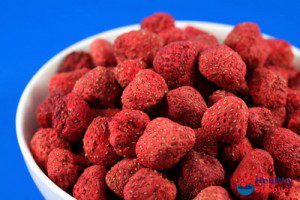By Mae Chan
Guest Writer for Wake Up World
It is well known that heat destroys most of the antioxidant potential of berries, making canned fruit and juicing that involves friction and heat poor choices for maximize their antioxidant potential.
The same is true of refrigeration. It appears that whenever fruit experiences temperature variants from its original state, antioxidant potential is affected — that is unless it is freeze dried.
Researchers at Sheffield Hallam University, UK measured Vitamin C, total antioxidant capacity (TAC), and total phenolic content (TPC) in fresh, chilled and freeze-dried strawberries.
Freeze-drying had no significant impact on nutrient content, but refrigerated fruit experienced large losses. Freeze-drying strawberries keeps all their Vitamin C and polyphenols and 92% of their antioxidants, saving more nutrients than by chilling which can lose over 80% of antioxidant concentrations.
Researchers at the Ohio State University Comprehensive Cancer Center examined the effect of freeze-dried black raspberries on genes altered by a chemical carcinogen in an animal model of esophageal cancer. The carcinogen affected the activity of some 2,200 genes in the animals’ esophagus in only one week, but 460 of those genes were restored to normal activity in animals that consumed freeze-dried black raspberry powder as part of their diet during the exposure.
[pro_ad_display_adzone id=”110028″]
“Freeze drying the berries concentrates these elements about ten times, giving us a power pack of chemoprevention agents that can influence the different signaling pathways that are deregulated in cancer,” said principal investigator Gary D. Stoner, a professor of pathology, human nutrition and medicine who studies dietary agents for the prevention of esophageal cancer.
Packaging Research Planned
John McAughtrie, technical director, Chaucer Foods, said the research highlights the nutritional benefits of freeze-drying fruit and vegetables: We are now planning to undertake further studies to compare the nutrient retention of freeze dried fruit and vegetables against those that have been dried using alternative technologies, and to consider the effects of packaging and storage on nutrient retention.
In the fruit chilled for seven days, TPC was reduced by 82% from fresh, Vitamin C was down by 19%, and 23% of TAC was lost. These are similar losses experienced through friction and heating mechanisms while juicing.
TPC is a measure of polyphenols, chemicals with antioxidant health benefits found in fruits, vegetables, tea and wine. The largest group of polyphenols is flavonoids, which can contribute to food’s color and mouth-feel.
The study also freeze-dried lime, orange, blackcurrant, broccoli and red bell pepper, and found freeze-drying had little or no negative effect on TAC, TPC or Vitamin C content of these foods.
How to Freeze-Dry Food
Freeze-drying preserves foods using a combination of cold temperature and dehydration. Fruits and vegetables are frozen, and water is removed from the food by reducing the surrounding pressuring so the frozen water moves straight from solid to vapor.
1. Choose the types of food you want to freeze dry.
Foods that contain high amounts of water work best for freeze drying. Their structure remains intact after the process. These foods hold up particularly well:
- Fruits like apples, bananas, berries, persimmons and pears.
- Vegetables like potatoes, peppers, carrots, sweet potatoes and parsnips.
2. Choose the freshest food possible.
Freeze drying food at the peak of its ripeness or freshness helps make sure it will taste good when it’s reconstituted. Fruits and vegetables should be freeze dried when they are in season and fully ripe.
3. Avoid freeze drying foods that won’t taste good reconstituted.
Berries and apples don’t need to be reconstituted – the freeze-dried version of these fruits tastes good as it is. Freeze dried meat or spaghetti, on the other hand, will need to be reconstituted with moisture in order to be edible. Don’t freeze dry foods for which this won’t be possible.
4. Process the food for freeze drying.
Get the food ready to be preserved by doing the following:
- If applicable, wash and dry the food thoroughly.
- Slice the food into small pieces. Cut apples, peppers, potatoes and other fruit and vegetables into small chunks, so that the moisture is easily removed.
5. Place the food on a plate or tray.
Spread it out so that the pieces of food are not clumped together.
6. Place the tray in the freezer.
If possible, make sure the freezer is empty of other items.
- Don’t open the freezer much while the food is freezing. This will slow the freezing process, and cause ice crystals to develop on the food.
- If you have a deep freezer, use it. The food should be frozen at the lowest temperature possible.
7. Keep the food in the freezer until it has freeze dried.
Over the course of about a week, the process of sublimation will take place, and all of the moisture will be removed from the food.
- Test to make sure the food is completely freeze dried by removing a piece and allowing it to thaw. If it turns black, the food is not freeze dried yet.
8. Store the food.
Once the food has completely freeze dried, place it in freezer storage bags. Push out the air, seal the bags, and store them either in the freezer, in your pantry, or in your emergency preparedness kit.
Other methods of freeze drying involve using dry ice and vacuum chambers.
Previous articles by Mae:
- Canadian Researchers Discover Evidence That Vitamin D Shuts Down Cancer Cells
- Just One Dose of Vitamin D Can Prevent The Progression of Multiple Sclerosis: 9 Day Remission In 92 Percent of Subjects
About the author:
Mae Chan holds degrees in both physiology and nutritional sciences. She is also blogger and and technology enthusiast with a passion for disseminating information about health.
This article was reposted with the express permission of the kind crew at preventdisease.com
[pro_ad_display_adzone id=”110027″]







